| |
|
All
Saints, Bawdeswell

|
|
Nothing
lasts forever. At a quarter nine in the evening
of the 6th November 1944, a Mosquito bomber
returning home from a raid on Gelsenkirken iced
up as it descended through cloud near the small
Norfolk town of East Dereham. The plane came
spiralling down towards the Norwich to Fakenham
road, and crashed right into the middle of the
village of Bawdeswell. Fortuitously, it landed
right on the village church, which it completely
destroyed. The wrecked building had been an early
Victorian church by John Brown, which itself had
replaced an 18th century mock-classical building.
The tower of the medieval All Saints had
collapsed into the church and destroyed it in
1739. As often in East Anglia, neglect of a
structure principally built of flint had led to
its demise.
Over
the centuries, English parish churches have
always been extensively rebuilt, but the process
just continued for longer at Bawdeswell than it
did elsewhere. When the villagers came to choose
a design for their new church, we may assume that
they at least looked at something modernist -
this was, after all, the 1950s, and the Festival
of Britain was encouraging the clean lines and
light spaces that would flush away the neurotic
elaboration and darkness of much of the
architecture of the first half of the century.
Barely a hundred miles off, one of the great
buildings of the century was going up in
Coventry, where the city's cathedral, formerly
the parish church of St Michael, had been gutted
in the blitz.
|
It is worth
pointing out that many surviving early 19th century
parish churches like the one destroyed by the returning
bomber have not worn well. Coming before the flowering of
that century's architecture, they tend to be dark and
dingy, their fittings are anachronistic, even absurd, and
there is no reason to think the parishioners of
Bawdeswell had a special fondness for the lost building.
Indeed, what they chose to replace it seems almost a
direct reaction. Rejecting both Gothic and Modernist
forms, they chose something that is basically
neo-classical, in the style of the 18th century but
perhaps also with the flavour of New England. The
materials, if you please, would not be concrete and steel
but Norfolk flint and shingle.
The church
sits near the centre of the village, set back politely
from the street behind a small green and what appears to
be intended as a carriage drive. A number of the old
headstones were reset on the western side of the
churchyard, and another intriguing survival is a large
cross set up beside the porch. It's inscription reads When
this church was destroyed on November 6th 1944 this cross
remained standing on top of the bell tower. The cross was
originally erected in loving memory of John Romer Gurney
who died March 29th 1932.
All Saints
has the homogenity that echoes the restored Wren City of
London churches. The mock-classical portal, which should
overwhelm, doesn't. The bell fleche and clock stage were
completed in the 1990s, and you step inside to a space
full of light, the simple wooden furnishings splendid
under the mainly clear glass set with roundels and panels
of continental glass, some 17th Century, some 20th
Century copies.
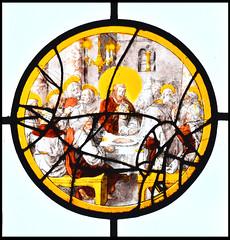 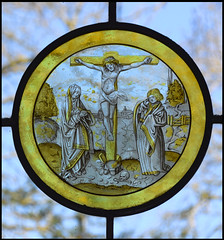 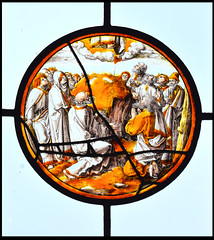
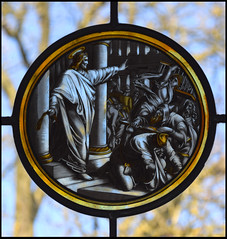 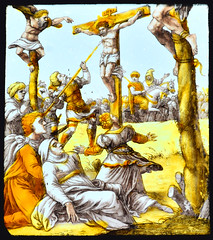 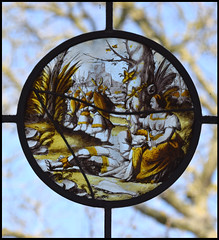
The architect was James
Fletcher Watson who, in his nineties, could return to the
fiftieth anniversary celebrations, and survey his work
with pride. At the time it was built, and in the decade
or so afterwards, his work here was scoffed at as being
in what Betjeman once described as 'ghastly good taste',
but the fact is that it has stood the test of time very
well indeed. At this distance, there is a
Festival of Britain cleanness and light to its lines, and
although it is a very simple building it resists the
blandness that would emerge in the 1980s
shopping-centre-school of neo-classical, as found at,
say, Quinlan Terry's Brentwood Cathedral.
To
emphasise the early 18th Century intentions of the
interior, Fletcher Watson insisted on a three decker
pulpit, which the parish were at first uncertain about.
They gave in when he designed one that could be easily
dismantled if necessary, and there it is, still in place
today. An organ gallery is tightly crammed into the west
end, perhaps the only not-entirely happy moment of the
interior, but in any case the eye is quickly drawn to the
grandeur of the column-flanked apse, the altar serious
and alone in the stark whiteness. One touching memorial
records the plane crash itself, recording the names of
James Maclean and Melvin Tansley, the pilot and co-pilot.
It is made from a piece of the recovered fuselage.
The
overall cost of the rebuilding and furnishings was
slightly less than £20,000, about half a million in
today's money, which seems very reasonable. Most of it
came from the War Damage Reparations Fund.
| In fact, no East Anglian
parish church destroyed in the Second World War
would be replaced by a determinedly modern, or
modernist, building. Some were not
replaced at all of course, for there seemed
little point in rebuilding those lost in the
Norwich blitz. The city already had enough
little-used worship spaces. Where churches were
replaced, there was usually a looking back to
what was there before. At Chelmondiston in
Suffolk for example, Basil Hatcher replaced the
destroyed church in textbook Decorated Gothic.
More famously, at Great Yarmouth, the vast civic
church of St Nicholas was rebuilt by the
eccentric Stephen Dykes Bower as if none of the
centuries from the 16th and 20th had even
happened.
And so in
retrospect it was never likely that the
Bawdeswell parishioners would be feverishly
dialling up the steel and concrete manufacturers.
And yet neither had they any reason to mourn for
the building they had lost. What they
chose instead is rather wonderful. All Saints is
a cool, bright, welcoming place, a refreshing
delight, a must see.
|
|
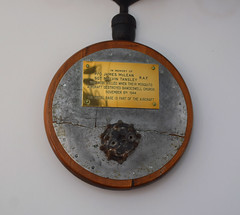 |
Simon Knott, March 2018
|
|
|
